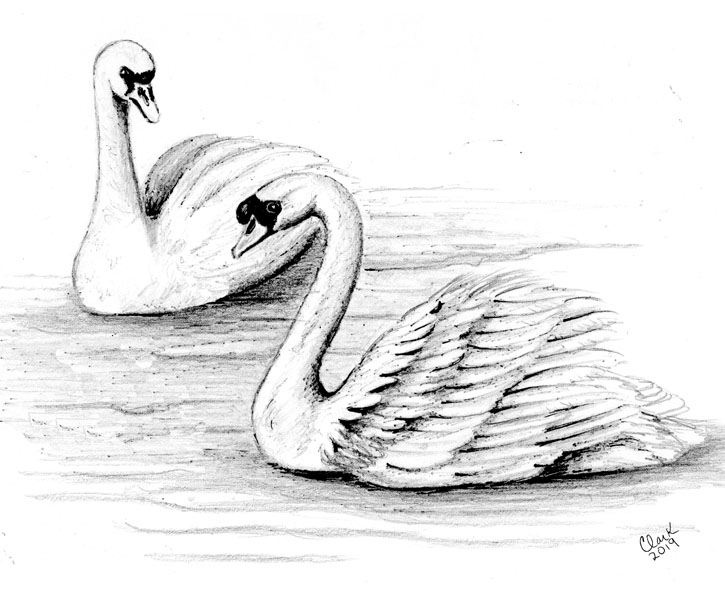
Dear Bird Folks,
Last summer a beautiful pair of swans hung out in the pond in front of our house. But when the cold weather moved in, they moved out. Where did they go? I know you don’t like swans, but we miss them.
– Jay, Attleboro, MA
This is a tricky one, Jay,
Anytime a species is super-successful, people invariably complain about it. They grumble that we have too many (pick one) turkeys, crows, squirrels, sharks, etc. Wildlife officials typically respond to such complaints by insisting that all creatures are part of the ecosystem and we simply have to adjust. When it comes to swans, however, it is the wildlife folks who are upset by the increase in population. The public, on the other hand, loves swans and can’t get enough of them. Whenever I suggest to people that swans are becoming a problem, they look at me in horror, as if I’ve just said something against rainbows or unicorns. (For the record, I love rainbows; they’re beautiful. Admittedly, though, I don’t get the unicorn thing. A horse with a horn? Huh? But I think we are getting off-topic.)
North America has two species of native swans. Of the two, the Tundra Swan is the most common and the most widespread. We also have Trumpeter Swans, which were nearly hunted into extinction in the last century. (Hmm, maybe that’s what happened to the unicorns.) As recently as 1935, only sixty-nine of these giant birds were known to exist. Happily, conservation efforts saved the birds and now their population is on the increase. Whew!
The swan that most New Englanders are in love with is the Mute Swan. They were introduced from Europe in the 1800s and their population has been growing ever since. Why does everyone adore them so much? Mated pairs remain together for life and humans like that (even if our track record of togetherness isn’t as stellar). They are also stately birds, holding their neck in a graceful S, often with their wings flared up like sails. (The wing thing is actually an aggressive posture, but humans find it charming.) Our culture also has a lot to do with it. Lush European art and fairy tales are filled with beautiful Mute Swan images. And then there’s Swan Lake, which turned out to be a ballet and not the bird watching story I was hoping to see. (I should have read the Playbill more carefully.)
Even if old-time literature has tricked us into liking Mute Swans, what is the harm you ask? Absolutely nothing. I want people to appreciate all birds, but the birds need to be in their native ecosystem. There isn’t anything wrong with European Starlings…in Europe. But they are a huge problem for many North American birds, and the same thing can be said about Mute Swans. Weighing twice as much as a Bald Eagle, Mute Swans are powerful birds, with few natural enemies. During the breeding season they are extremely territorial and will drive resident waterfowl from their nesting areas. They are also pigs. Swans can eat as much as eight pounds of plant material a day, stripping away food other birds depend upon. The paradox is that our native waterfowl is subject to hunting, while the invasive swans are not. Why not? Wildlife officials are well aware that most folks would freak out if their enchanting swans suddenly became targets. Instead, some officials have tried to control their population by addling eggs and hindering the birds’ breeding success. The hope is to keep the big birds confined to parks and urban settings and out of critical waterfowl breeding areas. Good luck.
Unlike other swans, Mute Swans are essentially non-migratory. They are true homebodies. Young birds travel a bit, but swan couples only move off their territories when forced to by winter’s ice or food shortages. And when they do leave it’s usually just to the nearest body of open water. After January’s cold snap, nearby saltwater inlets and bays suddenly became filled with swans looking for a place to spend the winter. Quite a few of them have been sheltering across from us in the Orleans Town Cove. Speaking of the Orleans Town Cove…
My favorite swan story happened last spring. A lady came into my shop and wanted to know if swans stayed in the same place or if they moved about. After I told her their stationary habits, she seemed annoyed. When I inquired the reason for her question, she told me she was renting a cottage on the Cove and the swans were making so much noise she couldn’t sleep. With all of the insincere sincerity I could muster, I looked at her and asked, “Really? Mute Swans are making too much noise?” The lady glared back, ready to argue and then burst out laughing. The “mute” part of the bird’s name had finally sunk in. I assured her that while Mute Swans aren’t totally mute (they occasionally make a few grunts and growls), they certainly aren’t loud enough to even keep an insomniac awake. She left, still laughing.
I’m sure your swans aren’t too far away, Jay. They probably have just moved to the nearby Seekonk River or to the waters around Fall River. I routinely see lots of swans in that area while driving on I-195. (I’m the one driving, not the swans.) Finally, don’t think for a minute that I don’t like Mute Swans; I’m just concerned about their potential harm to our native birds. If we aren’t careful, they could eliminate some other species without us knowing it. Just ask the unicorns.